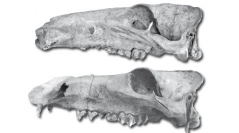

 Geodiversitas
36 (1) - Pages 117-161
Geodiversitas
36 (1) - Pages 117-161Since the 1900s, the Muséum d’Histoire naturelle of Toulouse has housed about 300 subfossil specimens of dwarf endemic hippopotamuses of Madagascar (Galliéni collection), neither described, nor determined so far. Thirteen cranial specimens, of which five complete skulls, two crania, a mandible and five fragments were described and measured. A comparative study of these specimens with those from the Natural History Museum, London, and from the Muséum national d’Histoire naturelle, Paris was undertaken, complemented by the analysis of a relatively complex and disputed literature. This study allowed referring six skulls to Hippopotamus madagascariensis Guldberg, 1883 and one to H. lemerlei Grandidier, 1868. We propose six new differential diagnostic characters for these species (external sagittal crest larger, shorter, and flatter in H. lemerlei; possible presence of a fontanelle instead of mastoid foramens in H. lemerlei; zygomatic arch more robust in H. madagascariensis; facial constriction longer in H. lemerlei; orbits more rostrally oriented in H. lemerlei, more laterally in H. madagascariensis; occipital condyles more axial in H. lemerlei and more caudo-ventral in H. madagascariensis in lateral view). Individual variation, sex- and/or age-dependent, is marked; besides, thorough examination of 20 ‘diagnostic’ cranial characters on the available sample shows that these characters are not unambiguously differential. Configuration of the orbit and relative length of the face are the most diagnostic features. Observed cranio-mandibular lesions are either traumatic (wounds: intra-specific struggles) or bucco-dental (dental wear/deletion, parodontolysis). These two species were probably sympatric, but occupying distinct niches
Dwarf hippopotamuses, Holocene, comparative anatomy, morphology, taxonomy, Toulouse Museum.